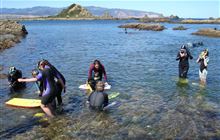Decade of marine protection on Wellington’s South Coast celebrated
Archived content: This media release was accurate on the date of publication.
Introduction
Marine life at Wellington’s Taputeranga Marine Reserve has flourished in the decade since it was created, Conservation Minister Eugenie Sage said yesterday.Date: 27 August 2018
The Minister joined iwi, conservationists, community members and school children to celebrate 10 years since the creation of Wellington’s Taputeranga Marine Reserve on Sunday.
The Department of Conservation’s monitoring of marine life in 2016 showed that there were more and bigger blue cod inside the reserve’s boundaries than outside it; rock lobster had become larger, heavier and more plentiful inside than outside. Adult paua are found in greater densities and are larger in size within the reserve than outside.
“The creation of this reserve was a tremendous achievement for the community who stood up and said bravely and firmly ‘we want this place protected’ – and who continue to cherish and enjoy it.”
“When Taputeranga was created it was New Zealand’s 33rd marine reserve. There are now 44 marine reserves in New Zealand’s territorial waters and we need to expand the network further and create new deep sea marine protected areas in the Exclusive Economic Zone,” Ms Sage said.
The Minister was joined members of Taranaki Whanui and Ngati Toa iwi, the Friends of Taputeranga Marine Reserve, DOC staff and some of the thousands of school students who have taken part in the ‘Experiencing Marine Reserves’ programme delivered by Mountains to Sea Wellington Trust.
Colin Ryder, Chair of the Friends of Taputeranga Marine Reserve said a range of contributions have shaped what the reserve is today.
“Thank you to our champions and advocates, our divers, snorkelers, shore-explorers, our subject-matter experts, authors, volunteers, DOC and Fisheries staff, the local Councils and our Trust - without these outstanding efforts, we wouldn’t be here celebrating.”
The reserve is within easy reach of more than 400,000 people. DOC’s Operations Manager for Kapiti-Wellington Jack Mace says this means many people get to experience the flourishing marine life.
“Not only do Wellingtonians love having a marine reserve on their doorstep, they are also committed to helping protect it.
“The public are great about reporting suspicious activity to us, which is vital in catching and deterring illegal fishers. We are in the final stages of training several community Coast Watch volunteers to have the same powers as DOC and Fisheries officers in this reserve,” Mr Mace said.
“This is just one sign of the incredible support the local community have shown this reserve over the past ten years.”
After a period of leniency and education for the first two years after the reserve’s creation, there have been 16 successful prosecutions, with 13 cases dealt with by way of diversion. Numbers show a steep decline in offences since 2013. Jack Mace believes this reflects greater public awareness of the marine reserve and the repercussions of unlawful fishing.
Marine reserves provide the highest level of marine protection and are a successful conservation tool, helping to conserve biodiversity and allowing ecosystems to return to a more natural state.
Research surveys have shown increases in species diversity, abundance and size of many marine species in marine reserves around New Zealand. Snapper, blue cod, rock lobster and paua have all shown increases in abundance and size in reserve sites, compared to non-reserves sites in many marine reserves.
Marine reserves are designated areas that are completely protected from the sea surface to the seafloor, including the foreshore. The entire area is strictly 'no take', including marine life, shells, rocks and driftwood.

